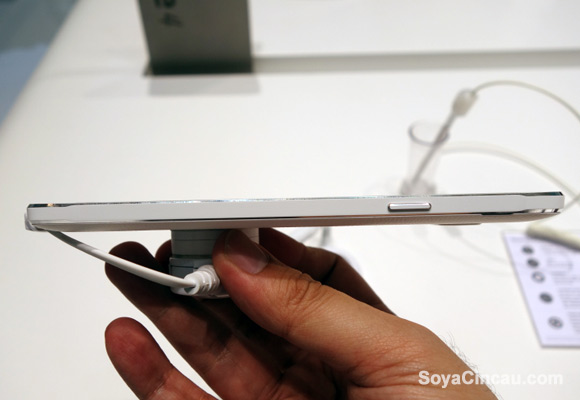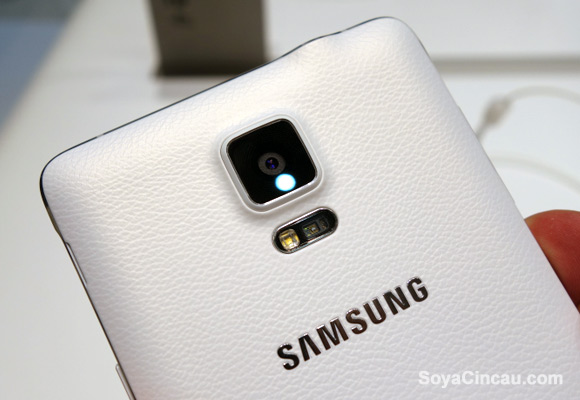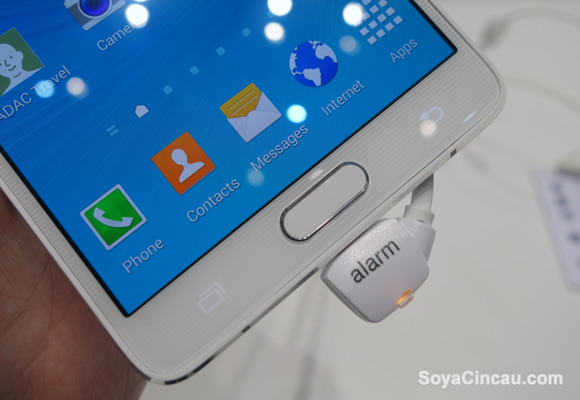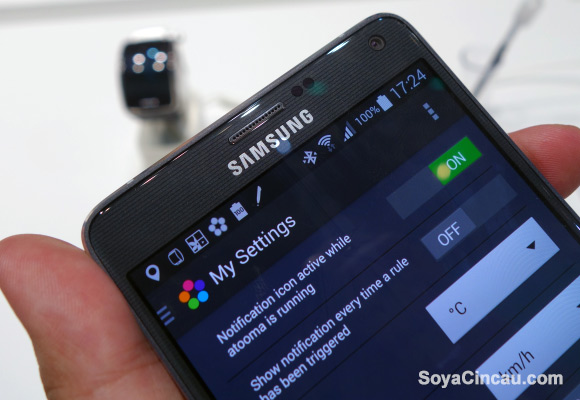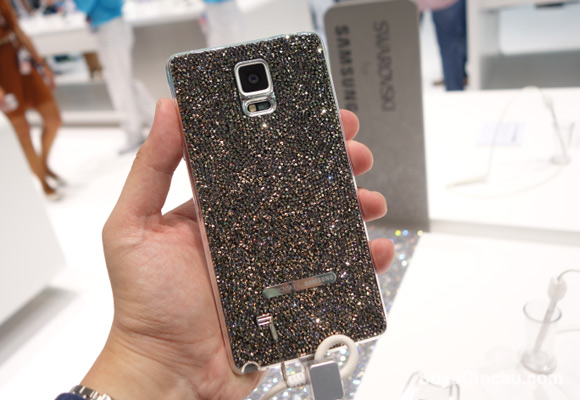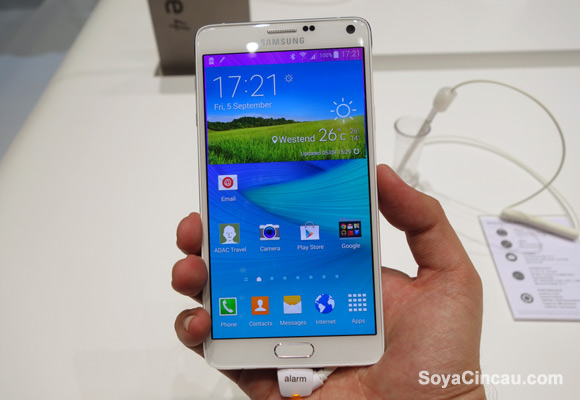The Samsung Galaxy Note 4 marks its 4th generation of its large form factor smart phone that’s paired with its signature S-Pen stylus. Announced during IFA 2014, this will be their current flagship device until the Galaxy S5 gets replaced early next year.
As most would expect, the Galaxy Note 4 gets upgraded specs with a choice of 2 processor variants and boasts further improvements with its S-Pen. In every new upgrade for the Note series, the screen gets bigger from 5.3″ on the original Note, to 5.5″ on the Note II and finally a bigger 5.7″ screen on the Note 3. This time around, Samsung has decided that 5.7″ is enough on the Note 4 and it gets upgraded to a higher Quad HD resolution that its competitors have been shouting for months now.
Read on for our first impressions with the Galaxy Note 4.
Exterior Design
To shed away its plasticky past, the Galaxy Note 4 comes with a metal frame that’s similar with the Galaxy Alpha. Instead of an exposed aluminium surface and it gets an added coat of colour that matches with its body. This is much better than the cheap looking plastic chrome frame on the current Note 3 and it feels much more expensive to hold.
The front gets a glossy all glass appearance with a discreet background pattern of horizontal lines surrounding the display. Meanwhile the back removable cover still has the same faux leather texture like the Galaxy Note 3 but it does feel better to touch on the Note 4.
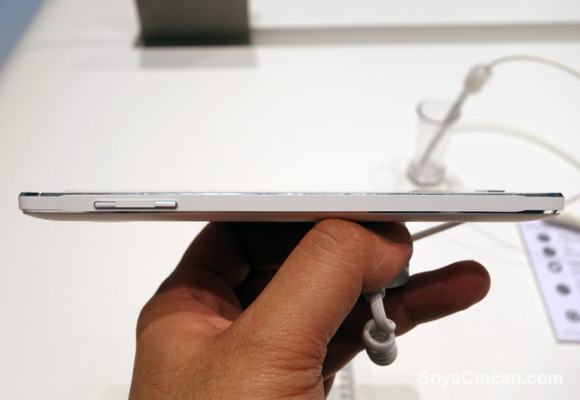
From the front, both the Galaxy Note 4 and Note 3 look similar except for its bigger front camera on the Note 4. It is only when you turn to the sides that the Note 4 stands out with its metal edges, while the back has a distinguishable heart rate sensor underneath the camera.
Dimensions wise, the Galaxy Note 4 is slightly narrower (Note 4: 78.6mm, Note 3: 79.2mm) than the Note 3 but it is thicker (Note 4: 8.5mm, Note 3: 8.3mm) and heavier (Note 4: 176g, Note 3: 168g) probably due to its metal frame. The placements for its volume rocker, power button, headphone jack and infrared blaster are identical on the Note 4.
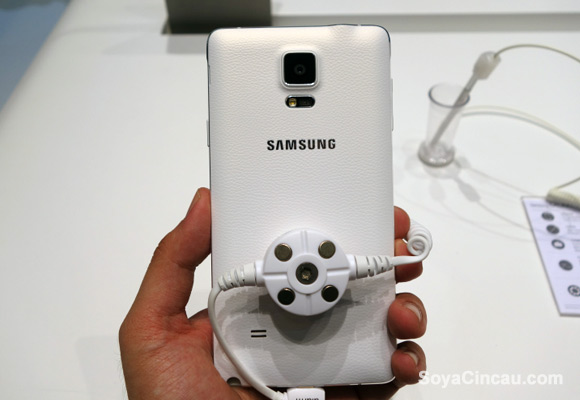
The only complaint we have is the speaker placement. On the Galaxy Note 3, the speaker grill was located at the bottom edge of the phone, which we find it pretty good. Unfortunately Samsung has returned the loud speaker to the back which means you would need to cup your palm around the back of the phone for louder output.
Hardware

The display on Galaxy Note 4 uses a Quad HD Super AMOLED display that pushes an ultra high resolution of 2560×1440. This is equivalent of compressing Galaxy Tab S display into a 5.7″ screen and that results a sharper and clearer display with a pixel density of 515ppi. Since it uses Super AMOLED panel, the Note 4 also offers Ultra Power Saving Mode which helps to extend battery life rigorously by switching its display to black and white. As you would expect, colours do appear extra vivid compare to its conventional LCD counterparts. It also has adaptive display to cater for different lighting conditions seamlessly.
Processing power won’t be a disappointment as on paper it runs on a much faster 2.7GHz Quad-Core Snapdragon 805 processor that’s mated to 3GB of RAM. Depending on market, there’s also an Exynos 5433 1.9GHz Octa-Core (1.9GHz Quad + 1.3GHz Quad-Core) variant as well. On-board the Galaxy Note 4 gets 32GB of storage like its predecessor and it is also expandable with microSD card supporting up to 128GB capacity.
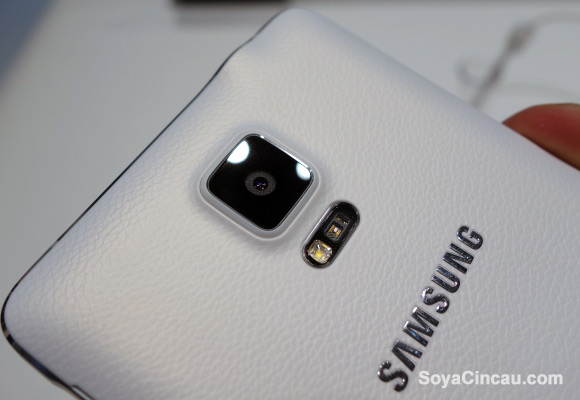
For taking pictures, Samsung has upgraded the Note 4’s camera from 13MP to a 16MP shooter. And for the first time on their flagship, it gets Optical Image Stabilisation for a steadier shot. As usual, the camera app comes with its wide selection of modes including real time HDR. Like past Samsung flagship models, the Note 4 is quite an eager snapper with its straight forward interface.
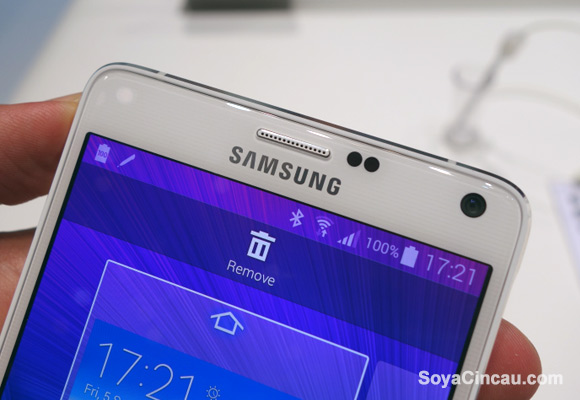
The front camera gets a huge bump as well considering how taking Selfies is a big thing right now. Samsung has been reluctant to go beyond its 2.1MP front camera and this time they have fitted a 3.7MP camera that has a bigger f/1.9 aperture and a wider 90 degree angle lens. If that’s not enough, they have also introduced a new Wide-Selfie mode which lets you take 120 degree angle selfies by combining a few photos which is quite similar with Huawei Ascend P7′s Panorama Selfie feature.
In the battery department, the Note 4 gets a negligible bump in capacity with a 3,220mAh battery (Note 3: 3,200mAh). Knowing that such a huge capacity battery would take longer time to charge, it is good to know there’s a Fast Charging feature that goes from 0% to 50% in just 30 minutes. That’s quick but isn’t as quick as Oppo Find 7‘s VOOC Charger that juices up to 75% in 30 minutes. Meanwhile the previous Note 3 took almost an hour to reach its 50% battery marker from zero.
Looking at the bottom end of the device, the Galaxy Note 4 has downgraded its micro USB connectivity from USB 3.0 to USB 2.0. The wider looking micro USB 3.0 port offers faster data transfer and it came with the previous Galaxy Note 3 and the Galaxy S5. So what this means, it will take longer for you to copy that huge 4K video file from the Note 4 to your computer. We wonder if this is a technical limitation with its Fast Charging Capability.
S-Pen and Software
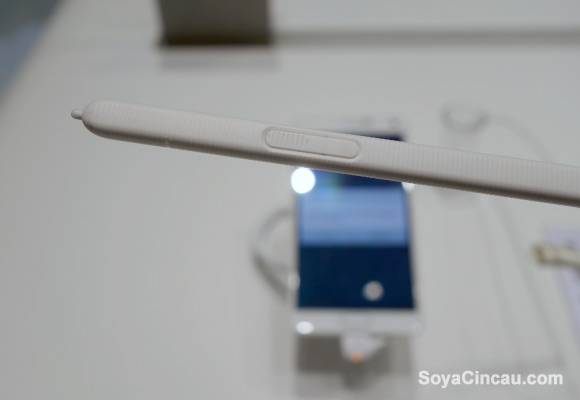
The S-Pen of course is the main highlight of the Galaxy Note 4. Being the pioneer of offering a stylus on smart phone, Samsung has enhanced the S-Pen, to make you want to use it more than ever before. The Galaxy Note 4 is now able to recognise 2,048 levels of pressure which is doubled from its previous model.
Its S-Note app has been improved as well with better selection of content from your current display and its Smart Select tool lets you collect multiple items in one go. Need to work from a printed or handwritten source? With its improved OCR (Optical Character Recognition), it easily converts hand writings and drawings to editable text and objects on your device.
Considering the Note 4 is a serious multi-tasking device, the Multi-Window feature has been revised with flexibility of resizing windows. In the previous Multi-Window version, it is restricted to view 2 windows with fixed full width of the screen. Now it is possible to create floating apps which can be toggled easily using the S-Pen.
Out of the box, the Galaxy Note 4 runs on the latest Android 4.4.4 and it retains most of its latest TouchWIZ UI that’s found on the Galaxy S5. One of the notable difference is its current running apps which now displays in a vertical wide looking carousel like how you would normally switch between tabs in Chrome.
Conclusion
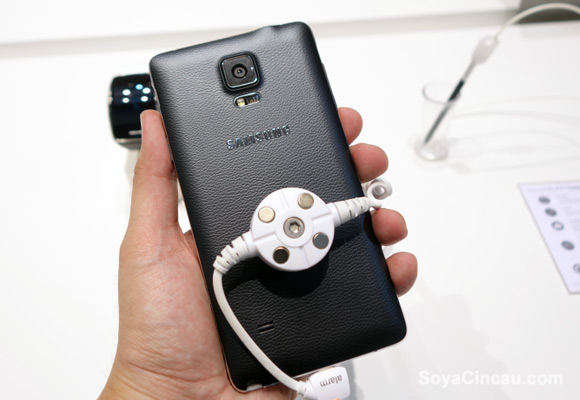
The Galaxy Note 4 delivers what everyone would have expected for a flagship. It has the best in class display and the highest spec’ed hardware that’s available in the market, until of course the next flagship comes along in 2015. The build quality and feel is much better than the previous model and it looks like Samsung is finally taking design more seriously to match with its expensive price tag.
Samsung is trying to prove that new S-Pen is mightier than your standard touch and tap interaction but it all depends on individual preference. In the past 3 models, we would leave the S-Pen in its silo most of the time. With the new version, it might stand a chance of being used more regularly and we’ll see if it does with long term use.
Samsung Galaxy Note 4 Hands-on Photos
